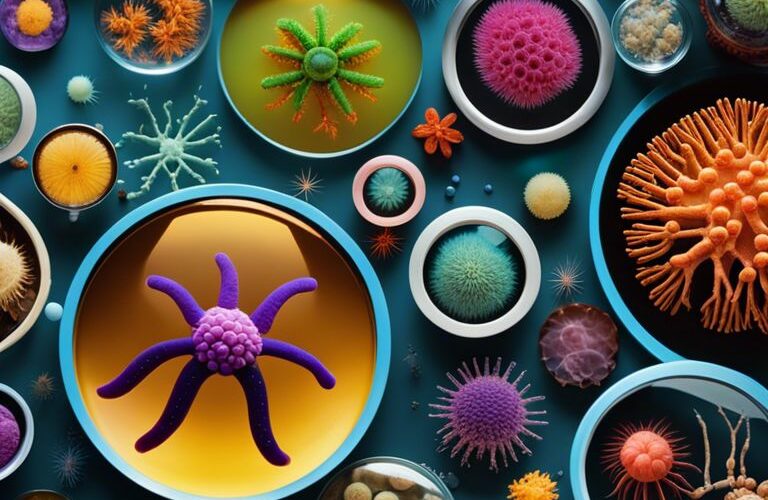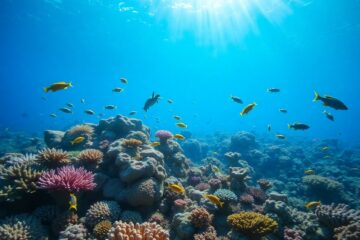Table of Contents
Microbial Diversity Proliferation
Everywhere on Earth
Proliferation of microbial diversity is a phenomenon that occurs across all corners of the globe. From the peaks of the highest mountains to the depths of the ocean floor, microorganisms thrive in virtually every environment on Earth. Whether it’s extreme heat, cold, acidity, or salinity, microbes have adapted to survive and flourish in conditions where most other forms of life cannot.
These microscopic creatures can be found in soil, water, air, and even within other organisms. Microbial biodiversity is essential for the functioning of ecosystems, playing crucial roles in nutrient cycling, decomposition, and maintaining overall ecological balance. Despite their tiny size, microbes have a massive impact on the health of our planet.
Billions of Species
Microbial biodiversity is so vast that scientists estimate there could be billions of species yet to be discovered. The sheer number of microbes on Earth is staggering, with untold diversity waiting to be explored and understood. These organisms come in a multitude of shapes, sizes, and functions, making them a rich source of biological diversity.
Among the billions of microbial species, only a fraction have been identified and characterized. The study of microbial diversity is an ongoing field of research, continually revealing new insights into the complexity and importance of these tiny but mighty organisms. Understanding the vast array of microbes on our planet is essential for unlocking their full potential and harnessing their benefits for various applications.
Marine Microbe Multitude
A vast and diverse ecosystem exists beneath the surface of the world’s oceans, teeming with an incredible array of microbial life. These microscopic organisms play a crucial role in maintaining the health and balance of marine ecosystems.
70% of Oxygen
On our planet, 70% of the oxygen we breathe is produced by marine microbes through photosynthesis. These tiny but mighty organisms, such as cyanobacteria and phytoplankton, are responsible for generating a significant portion of Earth’s oxygen supply.
Marine microbes are essential contributors to the global oxygen cycle, sustaining life not only in the oceans but also on land. Without these microscopic oxygen producers, life as we know it would cease to exist.
Vast Ocean Habitats
For marine microbes, the world’s oceans provide a vast array of habitats to thrive in, from the sunlit surface waters to the dark depths of the abyssal zone. These organisms can be found in every corner of the ocean, adapting to diverse environmental conditions.
It is estimated that the diversity of marine microbes is incredibly high, with countless species yet to be discovered and studied. Their adaptability and resilience make them a critical component of marine ecosystems, influencing nutrient cycling and food webs.
Soil Bacteria Abundance
Nutrient Cycling Essential
With over 1 billion bacteria found in just one teaspoon of soil, the abundance of soil bacteria is crucial for nutrient cycling in ecosystems. These microscopic organisms play a vital role in breaking down organic matter and releasing nutrients such as nitrogen, phosphorus, and potassium back into the soil.
Soil bacteria also help plants by converting atmospheric nitrogen into a form that plants can absorb, aiding in their growth and development. Without these bacteria, the cycling of nutrients would be severely disrupted, leading to nutrient deficiencies in plants and ultimately affecting the entire ecosystem.
Thousands per gram
To give you a sense of scale, there are thousands of different species of bacteria per gram of soil. This diverse array of bacteria contributes to the overall health and fertility of the soil, each playing a unique role in the ecosystem. Some bacteria form symbiotic relationships with plant roots, helping them absorb nutrients more efficiently, while others break down complex organic compounds, making them accessible to plants.
This vast microbial diversity also helps to maintain soil structure and prevent erosion. It is truly remarkable how such small organisms can have such a significant impact on the health of our ecosystems.
This incredible microbial diversity not only sustains plant life but also has a direct impact on human agriculture. The balance of soil bacteria is crucial for maintaining healthy crops and ensuring food security for the growing global population. Farmers and researchers are continually exploring ways to harness the power of soil bacteria to improve crop yields and make agriculture more sustainable in the long run.
10 Fascinating Facts About Microbial Biodiversity You Need To Know
Extreme Condition Survivors
Once again, microbes have shown us their remarkable ability to thrive in the most extreme conditions. From scorching hot temperatures to crushing pressures, these resilient organisms have found ways to adapt and survive where most life forms would perish.
Extreme temperatures endure
endureMicrobes have been discovered thriving in environments with extreme temperatures, ranging from boiling hot springs to freezing polar waters. In fact, some thermophiles can survive in temperatures exceeding 230°F (110°C), while psychrophiles can flourish in temperatures as low as -4°F (-20°C).
| Extreme Temperatures | Microbes |
| High | Thermophiles |
| Low | Psychrophiles |
These extremophiles have adapted unique mechanisms such as specialized cell membranes and enzymes to combat the harsh conditions they live in. Their ability to endure such extreme temperatures not only showcases their resilience but also expands our understanding of the diversity of life on Earth.
High pressure resistance
On the other end of the spectrum, some microbes have evolved to thrive in environments with high pressures, such as the deep sea or underground caves. These piezophiles can withstand pressures that are hundreds of times greater than atmospheric pressure, equivalent to the weight of several elephants pressing down on them.
Extreme pressure resistance in microbes is a fascinating adaptation that allows them to survive in environments where most organisms would be crushed. Studying these piezophiles not only provides insights into their unique biology but also enhances our knowledge of the limits of life on Earth and the potential for extraterrestrial life in extreme conditions.
Microbial Biofilm Formations
Not all microbial communities exist as free-floating individuals. In fact, many microorganisms prefer to live in biofilms, which are complex structures made up of communities of microorganisms surrounded by a protective matrix of extracellular polymeric substances (EPS). Biofilms can form on various surfaces, such as medical implants, teeth, and rocks, allowing microorganisms to thrive in a stable environment.
Protective communal clusters
To protect themselves from harsh environments and host immune responses, microorganisms often band together to form biofilms. These protective communal clusters provide resistance against antimicrobial agents, desiccation, and phagocytosis by immune cells. The EPS matrix shields the microorganisms within the biofilm, making it difficult for antibiotics or the immune system to eradicate the community.
Furthermore, biofilms promote inter-species communication and cooperation, enhancing the survival and growth of the microbial community. By sharing resources and exchanging genetic material, microorganisms in biofilms can adapt quickly to environmental changes, leading to increased resilience and survival rates.
Resistant to Antibiotics
For microorganisms living in biofilms, resistance to antibiotics is a significant challenge for healthcare providers. Due to the protective nature of the EPS matrix and the close proximity of cells within the biofilm, these communities are inherently resistant to antibiotics. Traditional antibiotics may struggle to penetrate the biofilm structure, allowing microorganisms to persist and potentially cause chronic infections.
It is imperative for researchers to develop new strategies and treatments to combat biofilm-related infections. By understanding the mechanisms of antibiotic resistance in biofilms and exploring alternative treatment options, we can better manage infections caused by these resilient microbial communities.
Microbial Influence on Climate
To understand the significant role of microbial biodiversity in shaping our climate, we must first look at the contributions of different microbial communities. Microbes have a profound impact on various climate-related processes, from methane production to carbon dioxide utilization. Let’s explore deeper into how microbial populations influence our planet’s climate.
Methane Production Contributors
Influence the most potent greenhouse gas, methane. Certain microbial communities, such as methanogenic archaea, play a crucial role in methane production. These microbes thrive in anaerobic environments, such as wetlands, rice paddies, and the digestive tracts of ruminant animals. Through their metabolic activities, methanogenic archaea produce methane as a byproduct, contributing to global warming.
Another group of microbes, known as methanotrophs, consume methane as their energy source. By balancing the methane production of methanogenic archaea, methanotrophs help regulate the levels of this potent greenhouse gas in the atmosphere. This delicate microbial interaction between methane producers and consumers has a significant impact on the Earth’s climate.
Carbon dioxide utilizers
Contributors microbial populations that play a vital role in carbon dioxide utilization are cyanobacteria, algae, and certain types of bacteria. These microbes are capable of photosynthesis, during which they convert carbon dioxide into organic compounds while releasing oxygen as a byproduct. This process not only supports the growth of these microbial communities but also helps reduce the amount of carbon dioxide in the atmosphere.
Apart from carbon dioxide fixation, some microbial communities utilize carbon dioxide in metabolic pathways, contributing to the cycling of carbon in various ecosystems. Their activities help maintain the balance of carbon dioxide levels in the atmosphere, influencing the global carbon cycle.
Human Microbiome Complexity
Now, let’s research into the fascinating world of human microbiome complexity. The human microbiome is a diverse ecosystem of microorganisms that reside in and on our bodies, playing a crucial role in our overall health and well-being.
Trillions of Microorganisms
Trillions of microorganisms call the human body home, outnumbering our own cells by about 10 to 1. These microorganisms include bacteria, viruses, fungi, and other microscopic organisms that form a complex community known as the human microbiome. The gut alone houses a significant portion of these microbes, aiding in digestion, nutrient absorption, and even influencing our immune system.
The diversity of microorganisms in the human microbiome is staggering, with thousands of different species coexisting and interacting in intricate ways. This microbial community is constantly evolving and can be influenced by various factors such as diet, lifestyle, and environment.
Health Impact Significant
One of the most fascinating aspects of the human microbiome is its significant impact on our health. These microorganisms play a crucial role in maintaining a healthy balance within our bodies, helping to regulate our immune system, metabolism, and even mood. Imbalances in the microbiome have been linked to a range of health issues, including obesity, autoimmune diseases, and mental health disorders.
Microorganisms in the human microbiome can either promote health or contribute to disease, highlighting the importance of maintaining a diverse and balanced microbial community. Researchers are uncovering new connections between the microbiome and various health conditions, paving the way for innovative treatments and interventions.
Ancient Microbial Life
Billions of years
Unlike human civilization that stretches back just a few thousand years, microbial life has been thriving on Earth for billions of years. These tiny organisms, invisible to the naked eye, have adapted and evolved over vast stretches of time, showcasing immense resilience and diversity.
Billions of years ago, microbial life played a crucial role in shaping the planet’s atmosphere and environment. Through processes like photosynthesis, these ancient microbes transformed the Earth’s atmosphere by producing oxygen, paving the way for the evolution of complex life forms.
Early Earth dominators
The early Earth dominators were extremophiles, a group of microbes capable of surviving in extreme conditions such as high temperatures, acidic environments, and high-pressure areas. These hardy organisms not only survived but thrived in harsh environments where other life forms could not.
The dominance of extremophiles during the early days of Earth highlights the resilience and adaptive abilities of microbial life. It underscores the fact that even in the most challenging environments, life finds a way to flourish.
It is fascinating to think that these tiny ancient microbes paved the way for the diverse ecosystems we see today. Their ability to survive and thrive in extreme conditions showcases the remarkable resilience of microbial life and its essential role in shaping the history and development of our planet.
Microbial Genetic Diversity
Vast gene pool
The microbial world boasts a vast gene pool, containing an incredible diversity of genes that far surpasses that of higher organisms. This genetic diversity is a result of the rapid reproduction and mutation rates of microbes, leading to a plethora of unique genetic variations within microbial populations.
The vast gene pool of microorganisms plays a crucial role in their ability to adapt to diverse environments and challenges, making them essential players in ecosystems around the world. These diverse genes encode a wide range of functions, from metabolic processes to antibiotic resistance, enabling microbes to thrive in a multitude of habitats.
Rapid evolution showcase
On a microscopic timescale, microbes demonstrate a rapid showcase of evolution through their ability to rapidly evolve and adapt to changing environmental conditions. This rapid evolution is driven by mechanisms such as horizontal gene transfer, genetic recombination, and natural selection, allowing microbes to quickly respond to new challenges.
Microbes’ rapid evolution showcase highlights their remarkable ability to overcome environmental pressures, including the development of resistance to antibiotics and other antimicrobial agents. This ability poses a significant challenge in public health as it contributes to the emergence of drug-resistant superbugs that can be difficult to treat.
Evolution in microorganisms can occur at a pace that outstrips the evolutionary changes seen in higher organisms, making them highly adaptable and versatile in their responses to environmental stresses. This rapid evolution also contributes to the diversity of microbial communities and their ability to colonize a wide range of habitats, from extreme environments like hot springs to the human gut.
Microbes in Technology
Many technological advancements in various industries have been made possible with the help of microbial biodiversity. Microbes play a crucial role in several technological applications, contributing to fields such as bioremediation, biofuel production, food production, and pharmaceuticals. Their diverse metabolic capabilities and adaptability make them valuable assets in technology.
Bioremediation agents used
An essential use of microbial biodiversity in technology is in bioremediation, the process of using living organisms to clean up pollution in soil, water, and air. Microbes are adept at breaking down harmful contaminants into less toxic substances, helping to restore environmental balance. Bacteria, fungi, and algae are commonly employed as bioremediation agents due to their ability to degrade a wide range of pollutants, including oil spills, pesticides, and heavy metals.
Microbes in bioremediation processes offer a cost-effective and environmentally friendly solution to cleaning up polluted sites. By harnessing the power of microbial biodiversity, industries can remediate contaminated areas more efficiently and sustainably, ultimately reducing their environmental footprint.
Biofuel production key
One significant application of microbial biodiversity in technology is in biofuel production. Microorganisms such as algae, bacteria, and fungi play a crucial role in converting organic matter into biofuels like biodiesel and bioethanol. These biofuels serve as sustainable alternatives to fossil fuels, helping to reduce greenhouse gas emissions and dependency on finite resources.
An interesting fact about biofuel production is that microbes are capable of producing biofuels from a variety of feedstocks, including agricultural waste, municipal solid waste, and even carbon dioxide. This versatility makes biofuel production a promising avenue for renewable energy generation, with microbes at the forefront of innovation in this field.
FAQ
Q: What is microbial biodiversity?
A: Microbial biodiversity refers to the variety of microorganisms present in a particular environment, including bacteria, archaea, fungi, and protists.
Q: Why is microbial biodiversity important?
A: Microbial biodiversity plays a crucial role in ecosystem functioning, nutrient cycling, and maintaining overall ecosystem health.
Q: How is microbial biodiversity studied?
A: Microbial biodiversity can be studied using various techniques, such as DNA sequencing, metagenomics, and isolation and culturing of microorganisms.
Q: What are some examples of microbial biodiversity hotspots?
A: Some examples of microbial biodiversity hotspots include soil, deep sea hydrothermal vents, and the human gut microbiome.
Q: How can we protect microbial biodiversity?
A: To protect microbial biodiversity, it is important to preserve natural habitats, reduce pollution, and promote sustainable agricultural practices that minimize the use of harmful chemicals.

Our contributing author is a passionate advocate for eco-friendly living and sustainability. With a background in eco-life, they are dedicated to inspiring and empowering individuals to adopt environmentally conscious lifestyles. Through insightful articles, they share practical tips, innovative solutions, and thought-provoking perspectives to promote a greener, more sustainable world. Join them on the journey towards eco-smart living and discover how small choices can make a big impact. 🌱









